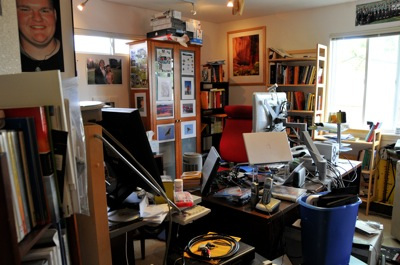Source: HABRAHABR.RU
What do I mean by “reference filing?”
Glad you asked! There are two components to my reference filing system: Evernote, and the Fujitsu ScanSnap iX500.
Evernote
Evernote is document storage and synchronization infrastructure. Pay $50 a year for a premium account, then install Evernote’s client software on as many Macs or PCs as you want, and all the documents in Evernote will be synchronized across all your computers without you having to take any actions. Evernote could be described as a means of providing “working backup” where your Evernote store is used on each of your computers, so you are testing your backups whenever you switch machines.
Key features of Evernote in decreasing priority value are:
- Full text search. Pictures, Word files, plain PDF files, and even some hand-written scans, are processed once a day so that the documents become full text searchable. Once you start using full text search, you tend to do much less organizing of documents into notebooks, because documents become so easy to find via keyword search and tagging.
- Friction-free capture of (advertising-free) web pages. <== Turns Evernote into short term memory for me.
- Keyword searching.
- Tagging.
- Friction-free synchronization.
- Cross computer availability of all mission-critical documents.
- Remote access to documents. Evernote has a cloud component, so you can be at an internet cafe, decide you want to print a document, and then log in to your Evernote account, download the file and print it.
Some people have their entire GTD system in Evernote. Not me. When I first started doing GTD I put my entire life into OmniFocus, and my brain hated the one-electronic-system-to-rule-them-all solution. I could not sit down at my desk and use OmniFocus after I had entered every open loop. Welcome to my first “off the GTD wagon” experience. Since then, I’ve been iteratively refining my GTD trusted system, keeping it as simple as possible, but no simpler.
I use Evernote purely for reference filing (purple region 3 in the following figure). Evernote has several nagging weaknesses: (1) it does not search within all file types, (2) It does not have a simple highlighting function. Lack of a highlighting function causes me to read documents in PDF form, highlighting them in PDF, and then emailing them to Evernote, and using Evernote just to recall documents and original source web pages.
Fujitsu ScanSnap S1500
I can’t say enough about this little machine. It enabled paperless reference filing, via Evernote. It folds up into a very small package. It scans fast enough that a 150 pages scan, in under five minutes. I strongly encourage you to at least go to Amazon and look.
Here is my sales pitch on selling you on buying a scanner:
- In under a week, you can be paperless via Evernote and the ScanSnap S1500. I started with 94,000 pages in December 2010 and in 4 days, I had recycled the entire 94,000 pages.
- Once you are paperless in Evernote, you will discover that you can “find” documents you never would have bothered to look for, while the document was in paper. I’ve found old newspaper articles that were handed out to me as a student, and then forwarded them to my students.
- When was the last time you could find any document that you knew you had? You can be there again with Evernote and a ScanSnap.
- There are four tricks to guaranteed scanner success:
- First, go through all your papers and sort them into boxes labeled “Recycle” and “Scan.” When in doubt, put the paper into your “Scan” box. Once you pre-sort, you will know which scanner to buy.
- Second, buy the right scanner for the amount of paper you need to scan. If you have less than 500 pages you can buy the slightly cheaper ScanSnap S1300. I did this at first when implementing Evernote. I found that the S1300 with its 12 page paper bin, and slow speed, was just too clunky to get it done with my piles of paper. If you have 400 pages to scan and a doubt about buying a slower unit, or, if you have 501 pages to scan, then you are crazy not to buy the ScanSnap iX500.
- Third, as soon as the scanner arrives, take it out of the box and put it on your desk.
- Fourth, once the scanner is on your desk, call your friend “Bill” the gadget guy and tell him what is on your desk.
- Remember “Meade’s Law” which is “Buy the best, only cry once.”
- I was lucky and a friend offered to buy my ScanSnap S1300, I warned him that he’d be happier with the iX500 but he insisted. By the way, “Thank you Steve!”
- For most people with a bureaucratic residue of disorganization, the Fujitsu iX500 is going to be the happiest, highest-utility long run solution.
- If you’ve read this far, ask yourself, “How long have I been thinking that a scanner ‘might be useful’? If you have been thinking about this for longer than a month, the time is now to GET YOURS. You won’t regret it.
What happens next?
One you have a reference filing system, you have an anchor set solidly into improved organization. Whenever your fall off the wagon with GTD, no matter what, your reference filing system will be in ever increasing order. Evernote and the ScanSnap make it easier to be organized, than to be disorganized. Once you have an anchor in improving your organization, you have a home base to work out from as you refactor your life to incorporate more effectiveness and more efficiency.
If anyone has had great experiences with other scanners, please post what scanner you have (make and model), how long you’ve used it, what the one best thing about it is, in the comments to this post?
Thank you!
bill meade

